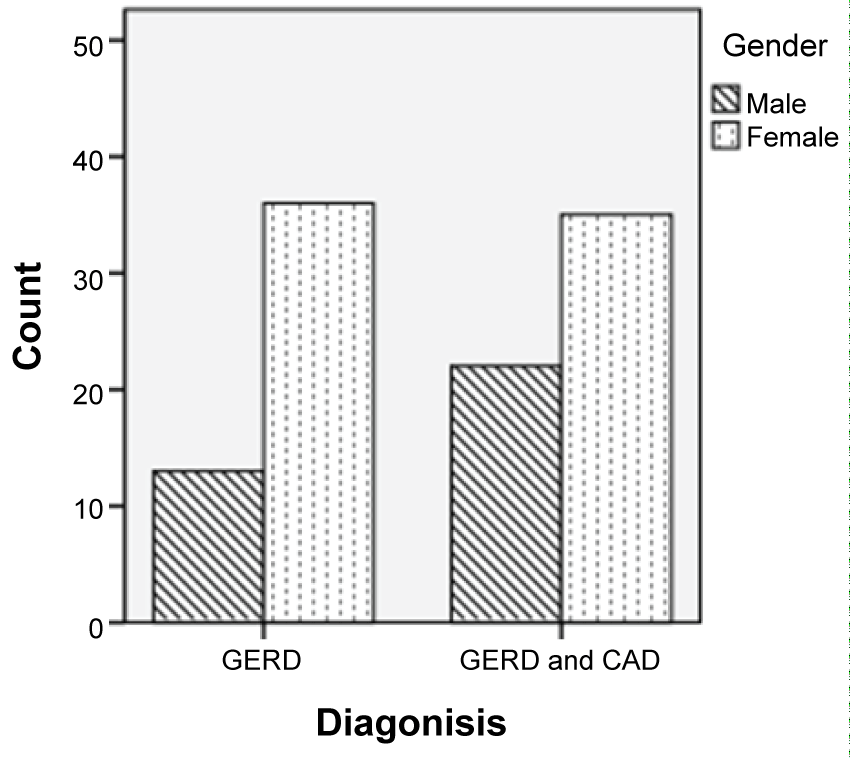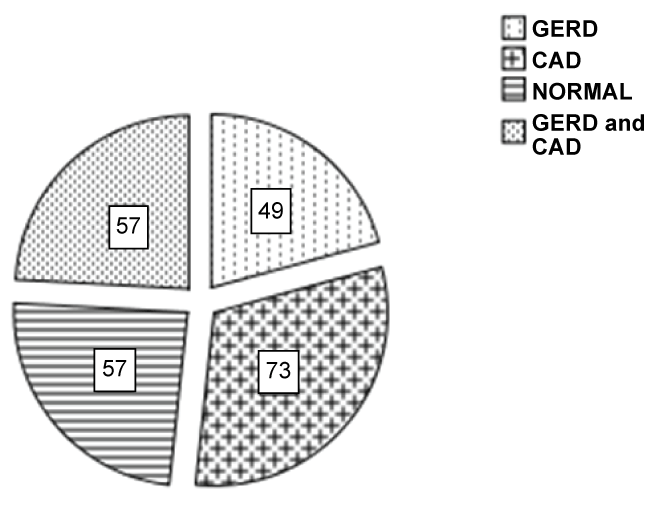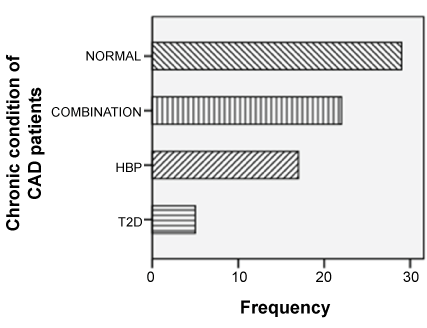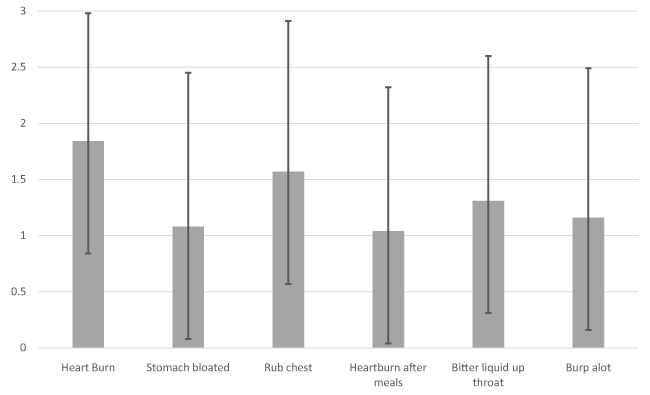Journal of Family Medicine and Disease Prevention
Prognosis of the Midlife-Elderly from ECG Testing to Gastroesophageal Reflux Disease and Coronary Artery Disease
Stephanie B Mohammed1, Andanappa Gadad2, B Shivananda Nayak1* and Vishi Beharry3
1Department of Pre-clinical Sciences, The University of the West Indies, Trinidad and Tobago
2School of Pharmacy, The University of the West Indies, Trinidad and Tobago
3Tejaswi Medical Centre, Trinidad and Tobago
*Corresponding author: B Shivananda Nayak, The University of the West Indies, Faculty of Medical Sciences, Department of Preclinical Sciences, Trinidad and Tobago, Tel: 868-6621873, E-mail: Shivananda.Nayak@sta.uwi.edu
J Fam Med Dis Prev, JFMDP-2-029, (Volume 2, Issue 2), Original Research; ISSN: 2469-5793
Received: December 24, 2015 | Accepted: March 29, 2016 | Published: April 01, 2016
Citation: Mohammed SB, Gadad A, Nayak BS, Beharry V (2016) Prognosis of the Midlife-Elderly from ECG Testing to Gastroesophageal Reflux Disease and Coronary Artery Disease.
J Fam Med Dis Prev 2:029. 10.23937/2469-5793/1510029
Copyright: © 2016 Mohammed SB, et al. This is an open-access article distributed under the terms of the Creative Commons Attribution License, which permits unrestricted use, distribution, and reproduction in any medium, provided the original author and source are credited.
Abstract
We investigated midlife-elderly patients enrolled for echocardiography and the prevalence of gastroesophageal reflux disease (GERD) and coronary artery disease (CAD). This was a cross sectional study. Patients (n = 236) enrolled for echocardiography (ECG) over the age of 30 were selected regardless of their chief complaint and those presented with chest pain were a key feature in this study. Patients free from known disease of age below 30 were excluded from the study. We investigated consented patients in a3 month period by issuing an F-scale questionnaire followed by an ECG. Our control group consisted of persons free from GERD or CAD. All patients were screened for GERD and/or CAD. We found that 57 were normal, 49 had GERD, 73 had CAD and 57 had both GERD and CAD. The most prevalent symptoms experienced by GERD patients were heart burn, rubbing of their chest unconsciously, bitter liquid emanation from their throat and feeling sick after meals. When analysed using SPSS chi-square test at the 95% confidence level, more females had GERD as χ2 (1) = 10.80 < 0.05 as p = 0.001 and both GERD and CAD which gave χ2 (1) = 7.07 < 0.05 as p = 0.008. Additionally, CAD patients had at least two chronic conditions including T2D and HBP as χ2 (9) = 19.8, p = 0.019. We found that on average, patients with chest pain were linked to having CAD; t (41) = 3.6, p = 0.001. Our present study showed the importance of midlife-elderly patients being recommended for ECG testing.
Keywords
Chest pain, Midlife, Elderly, GERD, CAD, ECG
Introduction
The classification of chest pain in relation to angina is defined as a substernal discomfort with distinguishing features and duration time in which the role of sex attributes significantly to the symptoms experienced by each gender [1,2]. An innumerable amount of persons who are presented with chest pain are still yet underdiagnosed in primary care and presently there exist only a minority of those patients who experience chest pain of a definite symptomatic feature that are being diagnosed with cardiac disease [3].
Chest pain experienced by patients can be of non-cardiac origin and the symptoms can be commonly related to as gastroesophageal reflux (GERD) [4]. Non-cardiac chest pain (NCCP) gastroesophageal reflux occurs at the same frequency in patients with both normal and pathological coronary angiographies [5]. Research has shown that approximately 50% of patients who experienced chest pain, assumed it was linked to CAD yet it was merely a symptom of being diagnosed with GERD [6]. In fact patients who experience symptoms of angina are really diagnosed as GERD [7].
GERD has been defined as a condition that develops when the reflux of stomach contents generates troublesome symptoms and/or complications [8]. Other research has profoundly defined it as heart burn and or regurgitation once a week or common [9]. The main symptoms of GERD are believed to be heartburn, retrosternal pain, regurgitation and less complicated symptoms such as bloating and the common cough which appears to diversify distinctly to the patient. It has been estimated that GERD affects 20-40 % of individuals in Western Countries [10] and surveys have also shown that approximately 20 % of US adults experience GERD symptoms such as heart burn and acid regurgitation at least once per week [11]. This condition has also been observed to be increasing within adults in Japan and studies are displaying the visibility of its symptomatic appearance in children. GERD is having a high incidence worldwide as it is affecting the quality of life with various equivocal symptoms [12]. Long term measures of GERD can advance to more serious complications such as heart disease and even death regardless of the countless independent randomized trials of medical and surgical treatments for it.
The mortality due to heart disease remains disconcerted and requires more in depth investigation [13].
The evaluation of the association between GERD and coronary heart disease was previously studied in Japan but has never been evaluated in a smaller less developed country such as Trinidad. The results obtained from the study in Japan revealed a link among patients with GERD and ischemic heart disease [14]. Coronary heart disease is a major problem in men and women. Symptoms of the acute coronary syndrome (ACS) include chest pain in both and additional back and jaw pain, nausea/vomiting, dyspnoea, indigestion and palpitations [15]. A study conducted in Japan with 1970 consecutive patients was presented to make the proper assessment for referral if diagnostic necessity arose for an ECG [14].
The main objective of this study was to evaluate the association of chest pain in relation to GERD and/or CAD with the use of the F- scale questionnaire designed by Kusano M et al. and an ECG [16]. This will be able to assist in simplifying disease management for patient’s experiencing symptoms of angina by providing physicians with the proper assessment for referral if diagnostic necessity arises.
Materials and Methods
Patients were recruited from the cardiovascular clinics of North Central Hospital Regional Authority (NCHRA) who were enrolled for echocardiography (ECG). Ethical approval was obtained from the ethic committee at the University of The West Indies, Trinidad. The selection of patients was made with identification in the database of individuals with a recorded diagnosis of chest pain. Patients over the age of 30 referred to ECG due to chest pain were included in this study. Persons suffering from any known diseases, pregnant women, mentally diminished patients and those suffering from Asthma or any known heart conditions that would affect results were excluded from the study. All selected patients were informed about the study and asked to give a written consent for their participation. Participants of the study were asked to complete an F-scale questionnaire which consisted of a series of questions regardless of their chief complains [16]. The F-scale is a well presented questionnaire designed previously by Kusana M et al. and the questions consisted of a series of scaled questions as seen in Table 1. Patients were asked to scale their answers as 0-never, 1-occassionally, 2-sometimes, 3-often and 4-always. These were the questions used to determine GERD symptoms.
![]()
Table 1: Showing the list of questions used to identify the GERD patients.
View Table 1
A statistical value of P < 0.05 was accepted as indicating statistical significance [17,18].
An ECG was performed on the patients by a physician from the relative diagnostic unit. The hospital records were additionally checked for basic data on the consented patients. The procedure basically followed a small part of the study path as conducted in Japan [14]. The data was statically analysed using the SPSS program.
Patients were classified into four major categories as being present with GERD, CAD, both GERD and CAD and normal if they had neither. From this they were then assessed for similar symptoms and chronic conditions mainly type 2 diabetes (T2D), hypertension (HBP) and hyperglycaemia to understand the prevalence of ethnicity, gender, chronic conditions and symptoms experienced occasionally.
Results
The sample size of 236 patients with a mean age of 59.86 ± 14.14 was issued an F-scale questionnaire and underwent ECG testing. After the distribution of a questionnaire and ECG testing, the physician was able to assess patients ECG in which 57 (24%) were normal, 49 (21%) had GERD, 73 (31%) had CAD and 57 (24%) had both GERD and CAD as shown in Figure 1.
Table 2 shows the demographic results obtained for all four groups. The prevalence of symptoms experienced by the GERD occasionally were shown to be heart burn, rubbing their chest subconsciously, feeling sick after meals and bitter liquid coming up their throat as shown in Table 3. The majority of all the patients with CAD did not experience any of the GERD symptoms. The normal group did not experience any of the symptoms as experienced by the GERD patients.
![]()
Table 2: Demographic Results for all groups.
View Table 2
![]()
Table 3: Distribution of symptoms in patients occasionally diagnosed with GERD.
View Table 3
Overall we observed that when analysed using SPSS chi-square test the male to female ratio of GERD patients gave χ2 (1) = 10.80 < 0.05 as p = 0.001 as shown in Figure 2 and there was also a difference between gender and the diagnosis of having both GERD and CAD which gave χ2 (1) = 7.07 < 0.05 as p = 0.008.

.
Figure 2: Bar Chart for distribution of male and female in GERD and GERD and CAD study population.
View Figure 2
Additionally, when all three major groups were compared with the normal group for chronic conditions, we did not see a clear pattern except for CAD patients which had at least two chronic conditions including T2D and HBP as χ2 (9) = 19.8, p = 0.019 as shown in Figure 3.
There were 42 patients overall who were presented with occasional chest pain. We found that on average, patients with chest pain were linked to having CAD; t (41) = 3.6, p = 0.001 as calculated by One-Sample T-test.
Discussion
Screening of both midlife and elderly persons regardless of their chief complaint is very important in making accurate assessments for their appropriate treatment of care and longevity. Our study highlighted the necessity for understanding these patients who present themselves as recommended by their physicians for regular check-ups. We specifically focused on chest pain, GERD and CAD in this study along with chronic conditions.
Our findings displayed that regardless of ethnicity GERD affected and will continue to affect all persons. This was previously seen in another study conducted in the United States, though African ethnicity persons were shown to have a lower prevalence of GERD symptoms [19]. GERD is a common disease in the midlife and elderly as its occurrence increases with age. The associations of symptoms were found to differ from those we would observe in the younger persons [20]. The prevalence of symptoms have shown to be roughly the same across both male and female nonetheless women indicated to suffer (P < 0.5) more frequently than men [21]. The most common symptoms include chest pain, dysphagia and heartburn. This was clearly observed in our study as patients with GERD complained of experiencing heartburn occasionally. Patients expressed their symptoms after intake of curry, spicy foods and coffee. These results were seen consistent with a previously reported study which showed the contribution of coffee, caffeine, spicy foods and other consumables such as citrus fruits and juices, chocolate and fatty foods in the development of GERD [22] (Figure 4).
Occasionally patients are referred for ECG in misperception with CAD. This complaint poses special diagnostic and therapeutic challenges in patients and if left untreated it can lead to more intricate diseases such as esophagitis, esophagitis ulceration and Barrett's esophagus [23,24]. Therapeutic options for these patients presently include lifestyle changes, medication and surgery. Some management treatment options also include the use of various medications such as proton pump inhibitors as it is safe for both short and long term therapy effect in patients, also anti-reflux surgery [25]. Special care must be taken in administration as drug interaction and treatment response must be monitored especially as these elderly patients take multiple drugs for various comorbidities [24].
The association of symptoms experienced by elderly patients such as chest pain can sometimes be under projected. This study showed that patients who experienced chest pain were linked to having CAD.
CAD has been considered to be one of the leading cause of death and morbidity in the industrialized world [26]. Diagnosis involves clinical evaluation, identification of dyslipidaemia, hyperglycaemia, biochemical risk factors and coronary imaging. Clinical factors include lifestyle and history of vascular diseases.
Non-invasive cardiac investigations such as ECG and chest x-ray have shown to be very helpful and the use of these methods is immensely important as basic resting ECG has shown to establish a baseline for comparison in future circumstances. The ECG assist in clarifying the differential diagnosis in detection of dynamic ST-segment changes, showing vasospasm, left ventricular hypertrophy (LVH), arrhythmias and much more [27]. The diagnostic accuracy of the use of an ECG was found to be 80.3% in a study on the “diagnostic accuracy and prognostic implications of stress testing for coronary artery disease in the elderly” [28].
The major risk factors found to be associated with CAD has been identified as abnormal levels of circulating cholesterol, HBP and T2D [29,30]. CAD has been shown to be a major cause of mortality in patients with T2D, HBP and hyperglycaemia [29]. However chest pain has been assumed to remain the cornerstone of CAD [27]. From our study patients with CAD were also found to have T2D, HBP and hyperglycaemia as expected. A limitation from this study was not recording the dietary lifestyle and the occupation of the patients as they can be contributory to the research.
It is advised that physicians apprehend the guidelines endorsed to be applied to stable patients suspected of CAD as sometimes these patients who present with chest pain can be considered as low risk acute coronary syndrome (ACS) [27]. Developing efficacious methods for patient care of both the midlife and elderly with multiple morbidities is very important. Patient care teams have the potential to improve the quality of care for the patients with chronic illness [31]. A happy life contributes to the longevity of these patients to an extent and we recommend that the physicians always endorse both clinical and non-invasive testing for the midlife and elderly regardless of their chief complaint [32].
Acknowledgements
Authors wish to thank nurse Grant and other staff at the clinic who assisted with ECG testing of the patients.
References
-
Albarran JW, Clarke BA, Crawford J (2007) 'It was not chest pain really, I can't explain it!' An exploratory study on the nature of symptoms experienced by women during their myocardial infarction. J Clin Nurs 16: 1292-1301.
-
Philpott S, Boynton PM, Feder G, Hemingway H (2001) Gender differences in descriptions of angina symptoms and health problems immediately prior to angiography: the ACRE study. Appropriateness of Coronary Revascularisation study. Social Science and Medicine 52: 1565-1575.
-
Ruigomez A, Rodriguez LA, Wallander MA, Johansson S, Jones R (2006) Chest pain in general practice: incidence, comorbidity and mortality. Fam Pract 23: 167-174.
-
Liu Y, He S, Chen Y, Xu J, Tang C, et al. (2013) Acid reflux in patients with coronary artery disease and refractory chest pain. Intern Med 52: 1165-1171.
-
Liuzzo JP, Ambrose JA (2005) Chest pain from gastroesophageal reflux disease in patients with coronary artery disease. Cardiol Rev 13: 167-173.
-
Jones MM, Somerville C, Feder G, Foster G (2010) Patients' descriptions of angina symptoms: a qualitative study of primary care patients. Br J Gen Pract 60: 735-741.
-
Vakil N, van Zanten SV, Kahrilas P, Dent J, Jones R; Global Consensus Group (2006) The Montreal definition and classification of gastroesophageal reflux disease: a global evidence-based consensus. Am J Gastroenterol 101: 1900-1920.
-
Singhal V, Khaitan L (2014) Gastroesophageal reflux disease: diagnosis and patient selection. Indian J Surg 76: 453-460.
-
Dent J, El-Serag HB, Wallander MA, Johansson S (2005) Epidemiology of gastro-oesophageal reflux disease: a systematic review. Gut 54: 710-717.
-
Van Lanschot JJB (2006) Integrated Medical and Surgical Gastroenterology.
-
Nebel LOT, Fornes MF, Castell DO (1976) Symptomatic gastroesophageal reflux: incidence and precipitating factors. Am J Dig Dis 21: 953-956.
-
Singhal V, Khaitan L (2014) Gastroesophageal reflux disease: diagnosis and patient selection. Indian J Surg 76: 453-460.
-
Spechler SJ, Lee E, Ahnen D, Goyal RK, Hirano I, et al. (2001) Long-term outcome of medical and surgical therapies for gastroesophageal reflux disease: follow-up of a randomized controlled trial. JAMA 285: 2331-2338.
-
Kato H, Ishii T, Akimoto T, Urita Y, Sugimoto M (2009) Prevalence of linked angina and gastroesophageal reflux disease in general practice. World J Gastroenterol 15: 1764-1768.
-
Patel H, Rosengren A, Ekman I (2004) Symptoms in acute coronary syndromes: does sex make a difference? Am Heart J 148: 27-33.
-
Kusano M, Shimoyama Y, Sugimoto S, Kawamura O, Maeda M, et al. (2004) Development and evaluation of FSSG: frequency scale for the symptoms of GERD. J Gastroenterol 39: 888-891.
-
Watanabe T, Urita Y, Sugimoto M, Miki K (2007) Gastroesophageal reflux disease symptoms are more common in general practice in Japan. World J Gastroenterol 13: 4219-4223.
-
Kusano M, Shimoyama Y, Sugimoto S, Kawamura O, Maeda M, et al. (2004) Development and evaluation of FSSG: frequency scale for the symptoms of GERD. J Gastroenterol 39: 888-891.
-
El-Serag HB, Petersen NJ, Carter J, Graham DY, Richardson P, et al. (2004) Gastroesophageal reflux among different racial groups in the United States. Gastroenterology 126: 1692-1699.
-
Raiha I, Impivaara O, Seppala M, Knuts LR, Sourander L (1993) Determinants of symptoms suggestive of gastroesophageal reflux disease in the elderly. Scand J Gastroenterol 28: 1011-1014.
-
Raiha IJ, Impivaara O, Seppala M, Sourander LB (1992) Prevalence and characteristics of symptomatic gastroesophageal reflux disease in the elderly. J Am GeriatrSoc 40: 1209-1211.
-
Kaltenbach T, Crockett S, Gerson LB (2006) Are lifestyle measures effective in patients with gastroesophageal reflux disease? An evidence-based approach. Arch Intern Med 166: 965-971.
-
Richter JE (2000) Gastroesophageal reflux disease in the older patient: presentation, treatment, and complications. Am J Gastroenterol 95: 368-373.
-
Ramirez FC (2000) Diagnosis and treatment of gastroesophageal reflux disease in the elderly. Cleve Clin J Med 67: 755-766.
-
Poh CH, Navarro-Rodriguez T, Fass R (2010) Review: treatment of gastroesophageal reflux disease in the elderly. Am J Med 123: 496-501.
-
Shah PK (2006) Risk factors in coronary artery disease, CRC Press, Taylor and Francis Group.
-
Task Force Members, Montalescot G, Sechtem U, Achenbach S, Andreotti F, et al. (2013) 2013 ESC guidelines on the management of stable coronary artery disease: the Task Force on the management of stable coronary artery disease of the European Society of Cardiology. Eur Heart J 34: 2949-3003.
-
Gentile R, Vitarelli A, Schillaci O, Laganà B, Gianni C, et al. (2001) Diagnostic accuracy and prognostic implications of stress testing for coronary artery disease in the elderly. Ital Heart J 2: 539-545.
-
Turner RC, Millns H, Neil HAW, Stratton IM, Manley SE, et al. (1998) Risk factors for coronary artery disease in non-insulin dependent diabetes mellitus: United Kingdom Prospective Diabetes Study. BMJ 316: 823-828 .
-
Wilson PW, D'Agostino RB, Levy D, Belanger AM, Silbershatz H, et al. (1998) Prediction of coronary heart disease using risk factor categories. Circulation 97: 1837-1847.
-
Wagner EH (2000) The role of patient care teams in chronic disease management. BMJ 320: 569-572.
-
Caselli G, Lopez AD (1996) “12 future longevity among the elderly”. Health and MortalityAmong Elderly Populations 235.








